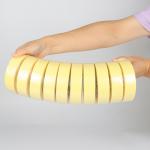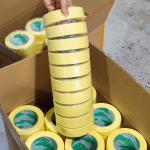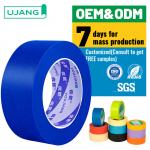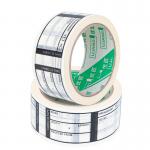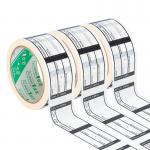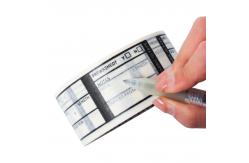The characteristics of crepe paper tape for paint masking are
mainly reflected in its material properties, masking performance,
operational convenience, and protective effects on painted
surfaces. Here’s a detailed analysis: 1. High Conformability and Liquid Resistance- Flexible Fit:
The unique crinkled structure of crepe paper gives it elasticity
and (ductility), allowing it to closely adhere to irregular
surfaces such as curves, edges, and gaps (e.g., corners of
furniture, pipe arcs, concave-convex automotive parts). This
creates a seamless masking boundary and reduces the risk of paint
seepage. -
- Anti-Penetration Coating:
Some professional paint masking crepe paper tapes feature a
waterproof coating (e.g., PE coating), which effectively blocks the
penetration of paint solvents (especially oil-based paints). This
prevents pigment diffusion into non-sprayed areas, ensuring sharp
and clear paint edges.
2. Gentle Adhesion: Easy Tearing and Substrate-Friendly- Moderate Tack Design:
The tape typically has low to medium adhesion (adjusted for
different substrates), ensuring firm attachment during painting
while allowing easy removal after drying. It leaves no adhesive
residue and does not damage the substrate (e.g., existing paint,
metal, plastic, wood), making it ideal for delicate spraying tasks
(e.g., automotive repairs, craft painting). -
- Clean Edge Removal:
High-quality crepe paper tape peels off with a neat edge,
preventing partial tape residue on the substrate and reducing
post-painting cleanup.
3. Heat and Solvent Resistance- Short-Term Heat Resistance:
Some models can withstand 60–80°C short-term high temperatures
(e.g., in baking processes), suitable for painting workflows
requiring low-temperature curing. They resist carbonization or
adhesive melting due to heat. -
- Solvent Resistance:
Professional masking tapes use chemical solvent-resistant
formulations for different paint types (water-based, oil-based,
enamel). This prevents the adhesive from being corroded by paint
thinners, ensuring stable masking performance.
4. Easy Operation for Enhanced Efficiency- Hand-Tearable and Precise Positioning:
The tape is (flexible) and can be torn by hand (no tools needed)
with a neat edge, ideal for on-site adjustments. When used with a
ruler or template, it can create precise straight or curved
boundaries, improving spraying accuracy. -
- Multi-Specification Versatility:
Available in various widths (e.g., 12mm, 24mm, 48mm) to suit
different spraying needs. Narrow tapes are suitable for detailed
masking (e.g., line separation, screw hole protection), while wide
tapes quickly cover large non-sprayed areas.
5. Environmental and Low-Pollution Features- Recyclable Material:
Most crepe paper tapes use degradable paper bases, meeting
environmental standards, especially for indoor decoration and toy
spraying. -
- Low Dust Shedding:
The tape’s dense surface coating minimizes fiber debris or dust
during application and removal, preventing contamination of the
spraying environment or affecting paint smoothness.
Typical Applications- Automotive Painting/Repairs: Masking body parts, window edges, and
rims to prevent overspray.
- Furniture Refurbishment: Separating wood grain and painted areas or
creating geometric spray patterns.
- Industrial Manufacturing: Protecting mechanical parts and
electronic components during spraying.
- Artistic Creation: Creating regular or irregular boundaries on
canvases/sculptures for spray art (e.g., street graffiti, pop art).
Precautions- Choose Tape for Paint Type: Use solvent-resistant crepe tape for
oil-based paints and standard types for water-based paints.
- Control Drying Time: Remove the tape promptly after the paint is
touch-dry (typically within 24 hours) to avoid adhesive buildup and
residue.
- Test Adhesion First: Test tape-substrate compatibility in a hidden
area to ensure no surface damage upon removal.
|
